10 Must-See Tourist Attractions in China
The most populous nation on Earth, the world’s second largest country in terms of land area, and a land of incredible cultural, historical and archeological riches, China is one of the world’s leading tourism destinations. With diverse geography and the legacies of historic civilization coupled with modern innovation, China’s must-see sites should be on any outdoor travel, archeology, or ancient architecture enthusiast’s list.
In this account, we discover sites ranging from the ancient Terracotta Warriors unearthed in Xi’an Province to the unbelievable feat of modern innovation that is the glass walkway clinging to the side of Tianmen Mountain, take a closer look at the Great Wall, and the Tomb of a leading female emperor.
10. The Terracotta Warriors
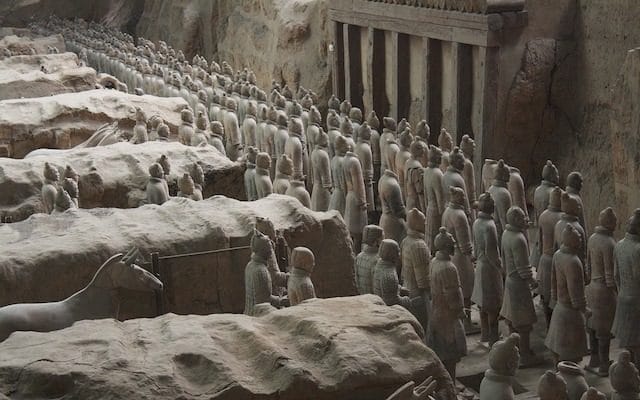
Standing in rank with an assortment of weapons and horses, the Terracotta Warriors form a spectacular mausoleum of international renown that attracts over 1 million visitors each year. Named the 8th Wonder of the World by French Prime Minister Jacques Chirac in 1978, the artifact site was discovered buried under a field in Linton District, Xi’an, in the centrally located Shaanxi province in 1974 by a farmer and his workers who were in the process of digging a water well.
Created late in the third century BCE at the order of the first emperor of China, Emperor Qin Shi Huang, to guard him in the afterlife, the Terracotta Warriors consist of a magnificent array of earthen likenesses of men, chariots and horses, complete with weapons and detailed uniforms standing below the surface of the surrounding land. The sculptures are a little larger than life-sized and, incredibly, are individualized, showing different soldiers with distinct expressions, postures, and clothing and adornment details.
Perhaps eerily, the degree of individualization suggests that real soldiers were replicated, one by one. Hundreds of Terracotta soldiers have been meticulously unearthed and preserved or restored to high standards. Currently, teams of archeologists are working to unearth large new sections of standing ranks. Four distinct pits are known, three of which have been excavated to a significant degree, while the fourth has not yet been unearthed. It is thought that an entire replica of the ancient City of Xi’an may exist in the emperor’s tomb located near the warrior pits.
9. The Forbidden City (Beijing)
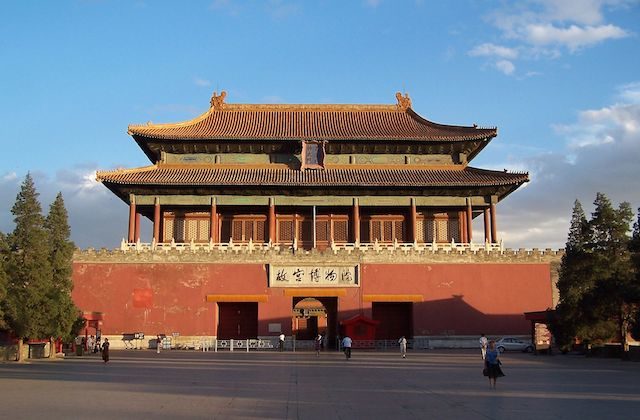
A prime destination for visitors despite its name, the Forbidden City is now open for public viewing of ancient, intricate and colorful imperial buildings that bring the ancient world to life in China’s capital, Beijing. Upon arrival, one will be faced with building after building amongst expansive squares, defined by traditional Chinese architecture constructed with fine south China jungle wood and Beijing marble. The Phoebe zhennan wood came from a tree sufficiently rare as to be outside the price range of all except ancient Chinese royalty.
Considered the definitive Chinese architectural accomplishment, this largest of palatial complexes on the planet originated in the years 1406 to 1420, serving as the ancient seat of Chinese government from the Ming up to the end of the Qing Dynasty. Built with the labor of over 1 million workers, the Forbidden City was so named due to the requirement for the Emperor’s permission to be given for anyone coming into or out of the city. Now, the preserved and extensively restored splendor of the Forbidden City attracts a whopping 14 plus million visitors per year, prompting concerns over the level of use of the site. The Forbidden City represents that greatest set of preserved ancient wooden buildings in the world, now recognized as a UNESCO World Heritage Site.
8. The Giant Wild Goose Pagoda
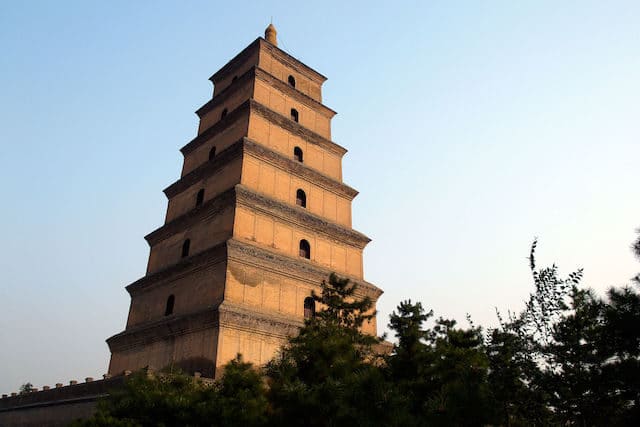
Rising from the grounds of the Da Ci’en Temple complexgrounds in Southern Xi’an, Shaanxi province, the Giant Wild Goose Pagoda dates back to 652 at the time of the Tang Dynasty. Accessible for a modest fee, the Giant Wild Goose Pagoda is a marvel of Chinese architecture with an iconic and commanding appearance. A World Heritage Site, the tower offers spectacular views of the city of Xi’an from the top, a panorama mixing ancient Buddhist architecture with modern buildings. The pagoda was erected to contain Buddhist artifacts brought from India to China by the highly regarded Chinese Buddhist translator and traveller, Xuanzang. According to legend, the name comes from the story of a wild goose falling from the sky at the spot to provide food for monks who had prayed for a meal.
Originally built from rammed earth, a construction method not generally known for being earthquake resistant, the structure collapsed in a 1556 earthquake before being rebuilt taller and stronger at the direction of China’s only female Emperor, Empress Wu Zetian. The rebuilt Giant Wild Goose Pagoda incorporated 5 additional stories, for a total of 10 stories. Yet, this tall structure was too high in relation to its stability and 3 stories simply toppled off, leaving the present day 7-story building that reaches a height of 210 feet. Reachable by a short walk from Da Yan Ta station on line three of the Xi’an Metro, the tower is built of brick with an interior winding staircase that matches the square shape of the building, fashioned from wood.
7. The Temple of Heaven (Beijing)
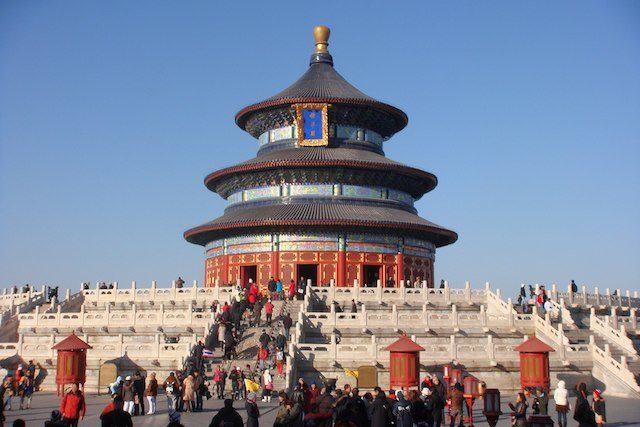
A mysterious looking circular building, the Temple of Heaven in Beijing was constructed in the year 1420 AD by Emperor Zhu Di of the Ming Dynasty, which spanned 1368-1644, and subsequently used into the Qing Dynasty of the years 1644-1911. The location of temple construction, the Royal Garden, had been used for Heaven worship from the beginning of the Ming dynasty. The largest sacrificial building constructed in Chinese history, the Temple of Heaven and its grounds cover an area even larger than the already enormous Forbidden City. Designed to represent mystical laws and principles of cosmology, the temple was a place where Heaven itself was worshipped during the Winter Solstice, when prayers for a bountiful harvest were offered.
The Temple complex consists of an area of 3,529,412 square yards and was deliberately made larger than the Forbidden City due to a prohibition on Chinese emperors living in a dwelling place of greater size than the construction dedicated to Heaven. The Emperor was regarded as the Son of Heaven, according to ancient Chinese culture, and a representative. Two times per year, the Emperor and his imperial accompaniers would camp in the complex to appeal to Heaven in hopes of successful harvests. The spectacular and iconic Hall of Prayer for Good Harvests is built upon a three-tiered marble base and spans 118 feet in diameter with a height of just over 125 feet. The other main elements of the site include the Imperial Vault of Heaven, a circle shaped building with one gable, while the Circular Mound Altar is an enormous set of concentric circles, the largest spanning just over 229 feet. The 360 balustrades symbolize the 360 degrees of heaven, which was seen representing the roundness of heaven as viewed in traditional Chinese culture.
6. Qianling Mausoleum (Resting Place of China’s Female Emperor)
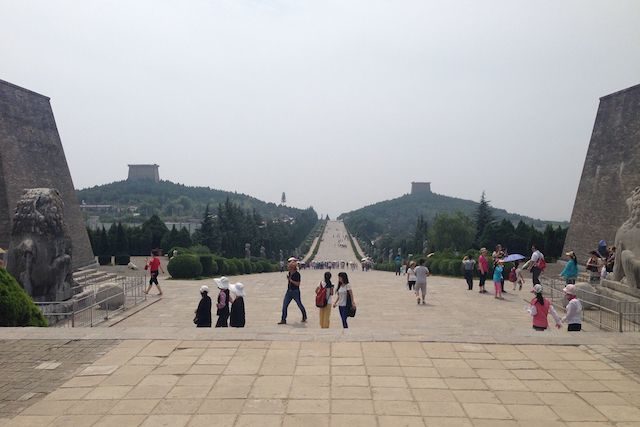
Originally just a concubine in the harem of Tang Dynasty Emperor Taizong, Wu Zeitan (624-705) took a spectacular rise to power that interrupted the Tang Dynasty once she declared her own Dynasty, a reign that would span from 690 to 705. Upon the death of Emperor Taizong om 649, Wu became an increasingly high ranking and influential concubine of his son, born Li Zhi, later becoming Emperor Gaozong. Having gained the favor of the Emperor, she became Empress Consort and through a serious of largely disputed but clearly brutal purges of rivals, established herself as Empress Regent, equivalent to the male title Emperor. In this role, she was to become the only recognized female Emperor of China in history. Her strict and aggressive but effective reign constituted the Zhou Dynasty, spanning from 690-705, interrupting the Tang Dynasty that began in 618 and ended in 907.
After a serious of aggressive military campaigns and spectacular construction projects completed at her direction, Wu Zetian weakened and died in December 705 at age 80 or 81. Wu Zetian is buried in a shared tomb in the spectacular Qianling Mausoleum, which is seen as the number one Chinese royal tomb and known as the only tomb containing the bodies of multiple emperors in China. Just 53 miles northwest of Xi’an, the Tang dynasty tomb complex was completed in 684. Subjected to numerous attempts at robbery over 1,200 years, the mausoleum is a guarded artifact that must be kept shut under Chinese law. The site is dramatic with vast gardens, walkways, and statues amongst panoramic mountain views, with two huge stone steles commissioned by Wu herself. One offers a rich tribute to her deceased husband, Emperor Gaozong (Li Zhi), but mysteriously, the other stele, commissioned for herself, is completely blank.
5. The Great Wall of China
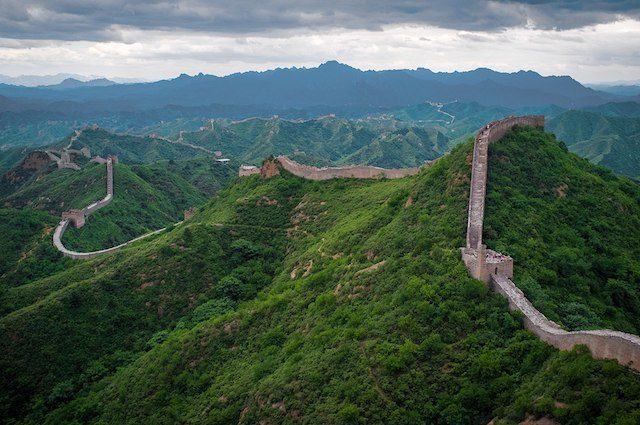
The Great Wall of China steadily extends across mountains and valleys, crawling up seemingly impossible grades while maintaining its grand structural integrity and a consistent appearance. A wonder of the world of paramount significance and iconic status, the Great Wall of China as it currently stands is primarily a Ming Dynasty relic of impressive defensive architecture. Attracting 10 million visitors per year, the wall is unfortunately facing significant impact pressures, yet conservation measures are challenging given the wall’s inter-jurisdictional span. Readily accessible from Beijing by a short bus ride, the wall spans multiple cities and provinces across China, with a length of 13,170 miles and numerous access points. To put that size in perspective, it is approximately half of the length of the equator in its extent. The most visited point of the wall, the Badaling section, received 63,000,000 million visitors in 2001, with visitor flow reaching 70,000 per day at peak times.
Perhaps the most surprising fact about the Great Wall is the fact that there is no single Great Wall from any particular time. Instead, the Great Wall is a combination of construction efforts from different dynasties and in different places. The 7th century BC saw the start of construction efforts intended to keep out raids from nomadic tribes from the steppes of Eurasia, while the famous first Emperor of China, Qin Shi Huang constructed massive sections of wall from 220 to 206 BC. While famous, that wall is mostly gone, with the largest portion of the current wall dating from the Ming Dynasty of 1368 to 1644, constructed to resist Mongolian and Jurchen invasions. With massive wall bodies, flanking towards and battlements, the Great Wall looks like a cross between a castle and a wall, and it is also the project with the greatest ever cost to human life and effort.
4. The Coiling Dragon Path (Hunan Province)
Located on the bizarre looking Tianmen Mountain in Zhangjiajie National Forest Park within Hunan province, the Coiling Dragon Path is defined by an eerie glass-bottomed walkway attached to the side of the mountain as it extends in a curving pattern for 330 feet, 4,600 feet above sea level. Opened in the summer of 2016, a fully sheer drop lies below as the path is stuck to the side of the cliffs of the thumb-shaped peak, plunging hundreds of feet to the base sections of the mountain below. In replacing the more rudimentary and also terrifying wooden path, the glass-bottomed path allows tourists to look directly beneath their feet at the ground far below as they advance along the side of the mountain on the impossibly curving glass walkway, brushing against the vegetation of the vertical mountainside.
Just 5 feet in width, the Coiling Dragon Path is accompanied by additional dizzying attractions, including a spectacular record breaker in the form of the Zhangjiajie Grand Canyon Glass Bridge, which is the world’s highest and longest glass-bottomed bridge. This bridge has been subjected to bizarre safety tests including being cracked with a sledgehammer, after which a car was driven across. The glass-bottomed bridge spans 1,410 feet, with a height of 984 feet above the floor of the Zhangjiajie Grand Canyon that it spans. Adding to the bizarre and stunning visuals of the site is a 431-foot high hole in Tianmen Mountain known as Tianmen Cave, accessible by a crazily winding road with 99 sharp bends that inches its way up the slopes.
3. The Bund (Shanghai)
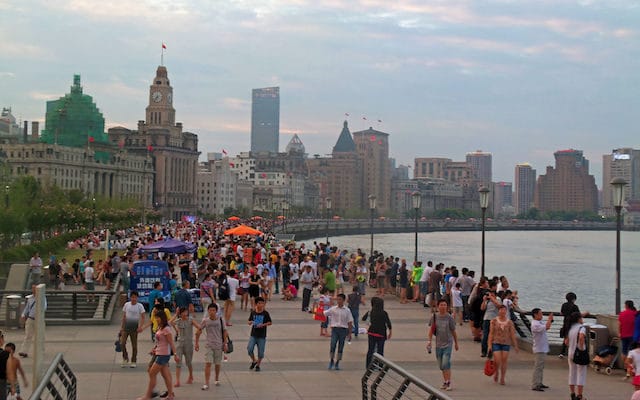
A complex of enormous colonial European buildings that are seemingly out of place, the Bund in Shanghai is comprised of 52 colonial buildings that include Baroque, Gothic, Neo-Classical, and Renaissance architectural styles, and the most extensive set of Art-Deco construction on the planet. Despite their foreign origin and appearance, the buildings of the Bund are seen as forming the definitive landmark of Shanghai, extending along the waterfront to include spectacular churches, hotels, and former government buildings. The buildings include trading and colonial posts of countries including the UK, France, Italy, Germany, Japan, the Netherlands, and Belgium, and the consulates of Russia and Britain.
Understood to be invaders by China, European colonists and soldiers engaged in conflicts that led to significant destruction of Chinese heritage property and cultural artifacts and imposition of trade and territorial concessions, most notoriously through the Opium Wars, where England declared war against China in 1839 in the First Opium War. As part of colonial settlement, the Bund served as a headquarters for enforcing trade and territorial concessions up the end of China’s final imperial dynasty, the Qing Dynasty (CE 1644-1911).
Viewed by China as unreasonable and labeled the “Unequal Treaties,” the concessions fell apart during and subsequent to the events of WWII. Closed down in 1949 as a result of Chinese displeasure with what was seen as a symbol of Western colonialism, the site is now viewed as a prime tourist destination and economic engine. Attracting scores of visitors each year, the buildings have been subject to extensive historical restoration efforts by the Chinese government and form one of the most visited tourism sites in China. Now, uses for the buildings include hosting museums, hotels and corporate centers.
2. Mount Huashan
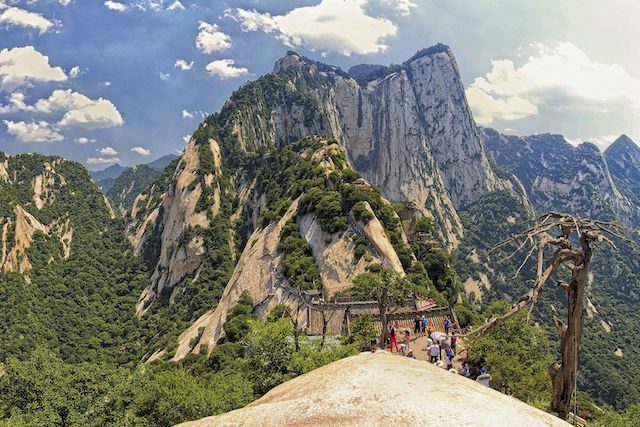
The 7,067-foot Mount Huashan, Shaanxi Province, offers a heart-stopping and unusual hike consisting of boardwalk sections strapped to the sides of the rising peaks and secured to each other with giant “staples.” A potentially dangerous “geotourism” site, the mountain rises dramatically above the surrounding foothills and farmlands. Stunning panoramic perspectives and firsthand views of sheer drops of unimaginable heights can be seen from the shockingly precarious chain hold and rickety wooden plank pathway called the “Plank Road” on the South peak of the mountain, which is known as “The Monarch of Huashan.” The plank road appears awkwardly rigged to the sides of the mountain and sometimes tilted towards it on an angle. At the end of the plank road, the “path” transforms to mere foot pegs jutting out of the mountain and footholds carved into the rock.
In fact, the sky walkways onsite are more akin to an assisted rock climbing experience where you had better hang on for your life with the help of the required harness than an actual developed “path.” Considered one of China’s five great mountains and a holy site dating back to the construction of a second century Daoist temple, the Monarch of Huashan has many sheer cliffs and a stout shape that may recall a giant peg or even a barnacle as it protrudes far above the surrounding peaks, reaching a staggering height of 7,070 feet. Mount Huashan has been labelled “The most dangerous hike in the world,” with widely disputed claims of high death tolls but an undeniably real risk of danger. Due to the popularity of Mount Huashan as an extreme hiking destination, concerns of crowding have become a significant problem, leading to numerous visitors choosing to climb at night.
1. Chengdu Research Base of Giant Panda Breeding
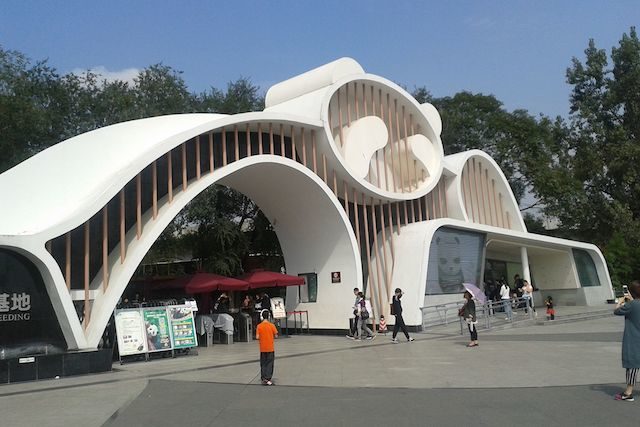
Not truly a bear, the Giant Panda is an icon not only of Chinese wildlife and biological diversity but a symbol of nature conservation globally and the logo of the World Wildlife Fund.
Considered vulnerable with a population of only 1,864 pandas remaining in the wild, the Giant Panda is restricted in range to mountainous regions of western China where they naturally live, breed, and forage in bamboo forests, subsisting almost 100 percent upon this gigantic grass species. Home to 83 pandas, the Chengdu Research Base of Giant Panda Breeding is located at the north end of Chengdu, the sub-provincial capital of Sichuan, a province known for spicy food, mountains, and bamboo forests on which the critically endangered Giant Panda depends. The majority of the Giant Panda range is in Sichuan province, with smaller populations in Shaanxi province and Gansu province.
The birthplace of 124 new pandas as of 2008, the Chengdu Research Base of Giant Panda Breeding started through the rescue of six pandas in the 1980s and aspires to be recognized as a world class destination for research, education, and international tourism. The site is readily accessible from downtown Chengdu by bus or vehicle but enjoys a wilderness setting. Awarded the categorization of “Class 4a National Tourist Attraction,” the center attracts an incredible 3.5 million tourists per year intent on viewing the pandas and seeing the breeding facilities, handler interactions, and surrounding lush forested hills. The site also has facilities to enable the gradual release of pandas into the wild, and conducts crucial fieldwork projects to research the ecology, conservation, and life history of pandas in the wild as well as pioneering panda conservation breeding techniques.
No comments:
Post a Comment